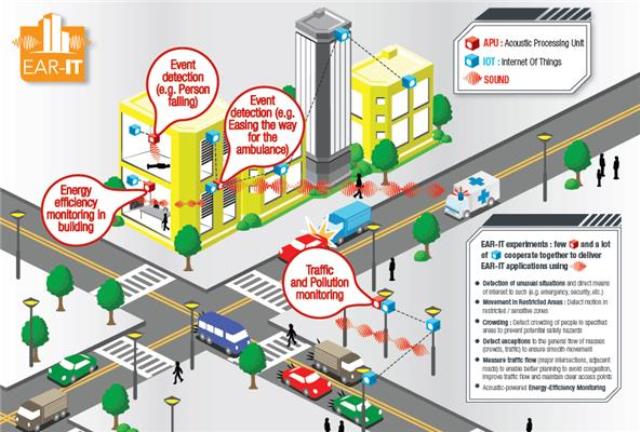Oct 24 2014
Have you ever thought about using acoustics to collect data? The EAR-IT project has explored this possibility with various pioneering applications that impact on our daily lives. Monitoring traffic density in cities and assisting energy saving devices in houses, for example, could enable the development of smart cities and buildings.
 EAR-IT: Using sound to picture the world in a new way
EAR-IT: Using sound to picture the world in a new way
The EAR-IT project has taken intelligent acoustic technology developed in laboratories and modified and adapted it to real life environments. The project, involving both research institutes and market advisors , has focused on outdoor and indoor applications: traffic flow monitoring and controlling the use of energy indoors based on the number of people in a room.
Helping urban traffic flow more smoothly and safely
As part of the FIRE initiative (an EU future internet concept), the city of Santander in Spain had turned itself into a huge experimental research facility, SmartSantander . It is the test bed for EAR-IT’s outdoor applications: traffic flow monitoring at a junction near the city’s hospital and analysis of traffic density on two city streets.
Project coordinator Prof. Pedro Maló explains, ‘The complex junction was the scene of quite a few traffic incidents. Traffic comes in a variety of directions and emergency vehicles are trying to get through. EAR-IT has set up sensors which ‘hear’ sirens and then trigger other sensors to track the vehicle. This data is then used to change traffic lights in the ambulance’s favour.’
The sensors can help get people to hospital more safely and quickly, but they can also send a message to a smart phone app to say if a concert is happening near you, or a street event you might enjoy. Once the sensor is in place the data it collects can be used for a wide range of applications.
The project also tested the sensors’ ability to count cars on a road. To check the data collected was accurate EAR-IT used two streets which had electromagnetic induction sensors under the tarmac.
‘I was really relieved and delighted when, after a year of work to adapt the technology to a city environment, we found the acoustic and pressure sensors were giving us the same message,’ says Prof. Maló. While the street sensors can just count the cars, the acoustic sensors have a wide range of applications.
The confirmation that the sensors can identify the number of cars passing, even when they go by in large groups, means that not only can the equipment be used to check traffic density hot-spots, but they can also, for example, be used in conjunction with pollution detectors. This could be vital tool in the EU’s bid to improve air quality for its urban population.
Notably, EAR-IT is taking advantage of the unique SmartSantander experimentation infrastructure and has deployed 12 000 devices all over the city. Devices run on batteries and most of them are installed in lamp posts to ensure energy sustainability. The small batteries recharge overnight as the electricity flows and so need next to no maintenance.
Energy efficient, secure homes – a sound idea
EAR-IT has also worked on the use of acoustic data in the home to save energy by assessing what is going on in a room and how many people are in it. ‘Windows can be made to open, curtains close and lights and heating turn on and go off automatically’, explains Prof. Maló, adding that users can choose their settings.
One very important application, in the light of Europe’s ageing population, would be the use of acoustic sensors to detect if someone is safe at home. They could transmit a distress message if someone falls, for example, letting healthcare providers and family know if they need to intervene.
The need for privacy is not forgotten
With all the benefits the technology can bring, the project is well aware of the need to ensure no one’s privacy is violated. It has created a tool for developers wishing to use acoustic sensors, which is available from the project’s website. This assesses the situation, tells them of possible legal issues and proposes solutions to ensure our private lives remain private.
http://cordis.europa.eu/result/rcn/149053_en.html
Source: http://cordis.europa.eu/